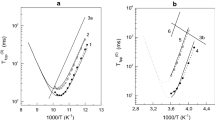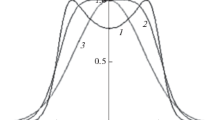Abstract
The theoretical description of relaxation processes in a scalar-coupled two-spin system containing a quadrupole nucleus (I = 1/2, S = 5/2) is presented, presuming that the relaxation is determined by dipole interaction between I and S spins, quadrupole interactions of the nucleus S, and the anisotropy of the chemical shift of both nuclei CSA (I) and CSA (S). The interference terms (cross correlation terms) between these types of interactions D-Q, D-CSA, and Q-CSA are also taken into account. Within the framework of the theory of a density matrix in the second order of perturbation theory, the relaxation equations in the operator representation for describing the longitudinal and transverse relaxation of a nucleus with spin 1/2 are derived. A formalism for the angular momentum operators of scalar coupled spins IS is developed, which makes it possible to calculate a spectrum pattern of a nucleus with a half spin, scalar coupled to a quadrupole nucleus with any spin. The proposed procedure has allowed us to find linear combinations of operators which can be considered as the projective operators responsible for each spectral component of spin 1/2, scalar coupled to a quadrupole nucleus (S = 5/2). The relaxation equations allowing investigation of the longitudinal and transverse relaxation of each component of the spectrum of a half-spin nucleus are obtained. The rates of longitudinal and transverse relaxation and also the rate of cross relaxation between the components are determined.
Similar content being viewed by others
REFERENCES
J. Cavanagh, W. J. Fairbrother, A. G. Palmer III, and N. J. Skelton, Protein NMR Spectroscopy, Academic Press, San Diego, California, (1996).
J. N. S. Evans, Biomolecular NMR Spectroscopy, Oxford University Press, Oxford (1995).
A. Kaikkonen and J. Kowalewski, J. Magn. Reson., 146, 297–310 (2000).
M.-D. Tsai and K. Bruzik, in: L. J. Berliner (ed.), Biological Magnetic Resonance, Vol. 5, Reusen (1983), p. 129.
M. J. S. Kelly, C. Krieger, L. J. Ball, Y. Yu, G. Richter, P. Schmieder, A. Bacher, and H. Oschkinat, J. Biomol. NMR, 14(1), 79–83 (1999).
L. G. Werbelow and R. E. London, J. Chem. Phys., 102, 5181–5189 (1995).
A. Grzesiek and A. Bax, J. Am. Chem. Soc., 116, 10196–10201 (1994).
R. E. London, D. M. LeMaster, and L. G. Werbelow, J. Am. Chem. Soc., 116, 8400–8401 (1994).
I. P. Gerothanassis and N. Sheppard, J. Magn. Reson., 46, 423–429 (1982).
G. A. Gray and T. A. Albright, J. Am. Chem. Soc., 99, 3243–3248 (1977).
L. G. Werbelow, D. A. Ikenberry, and G. Pouzard, J. Magn. Reson., 51, 409–413 (1983).
L. G. Werbelow and G. Pouzard, J. Phys. Chem., 85, 3887–3891 (1981).
J. S. Blicharski, Acta Phys. Polon., 36, 211–218 (1969).
G. S. Kupriyanova, Appl. Magn. Res., 19, 161–178 (2000).
A. G. Redfield, Adv. Magn, Res., 1, (1965).
G. K. Fraenkel, J. Chem. Phys., 42, 4275–4298 (1965).
L. G. Werbelow, G. A. Morris, P. Kumar, and J. Kowalewski, J. Magn. Reson., 140, 1–8 (1999).
A. Abragam, Principles of Nuclear Magnetism, Clarendon Press, Oxford (1991).
M. Goldman, J. Magn. Reson., 60, 437–452 (1984).
M. Goldman, J. Magn. Reson., 149, 160–187 (2001).
B. D. Nageswara Rao, Adv. Magn. Reson., 4, 271–296 (1970).
G. S. Kupriyanova, Zh. Prikl. Spektrosk., 68, 239–242 (2001).
K. Blum, Density Matrix Theory and Applications [Russian translation], Moscow (1983).
R. R. Ernst, G. Bodenhausen, and A. Wokaun, Principles of Nuclear Magnetic Resonance in One and Two Dimensions [Russian translation], Moscow (1990).
N. Chandrakumar, in: NMR Basic Principles and Progress, Vol. 34, Springer-Verlag, Berlin–Heidelberg (1996), pp. 1–115.
L. C. Biedenharn and J. D. Louck, in: Angular Momentum in Quantum Physics [Russian translation], Moscow (1984), p. 47.
Author information
Authors and Affiliations
Rights and permissions
About this article
Cite this article
Kupriyanova, G.S. Relaxation Equations in Operator Representation for a Multipolar Spin System (1/2, 5/2). Journal of Applied Spectroscopy 70, 86–94 (2003). https://doi.org/10.1023/A:1023276526156
Issue Date:
DOI: https://doi.org/10.1023/A:1023276526156




